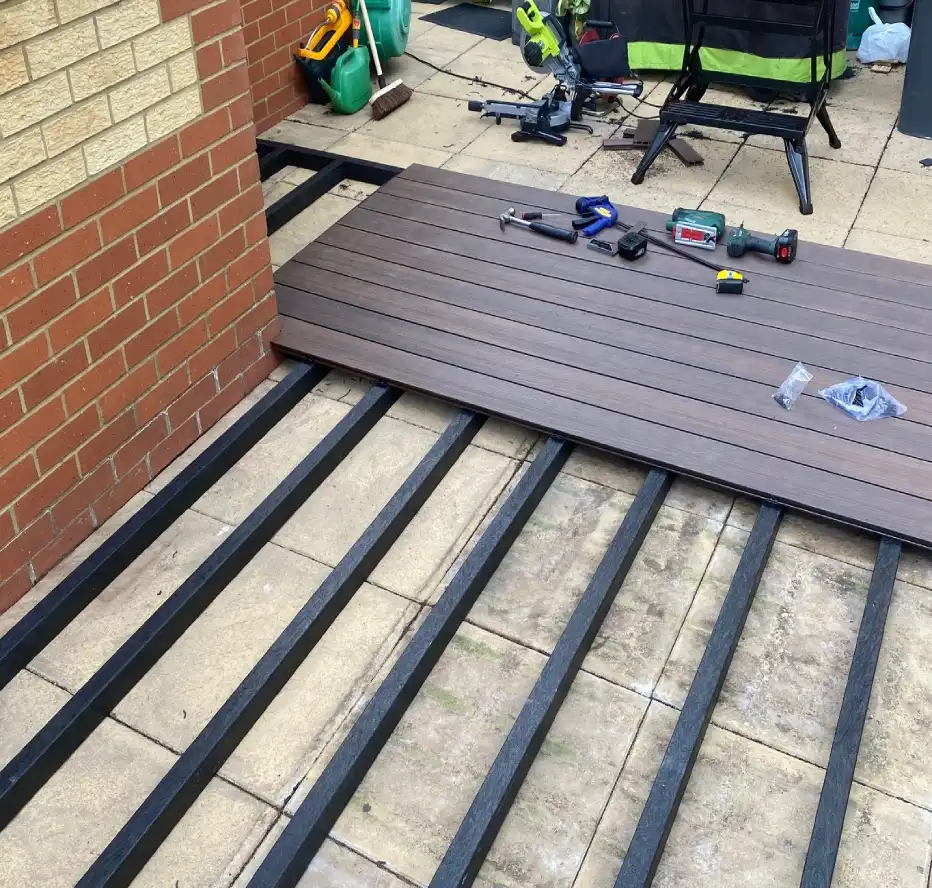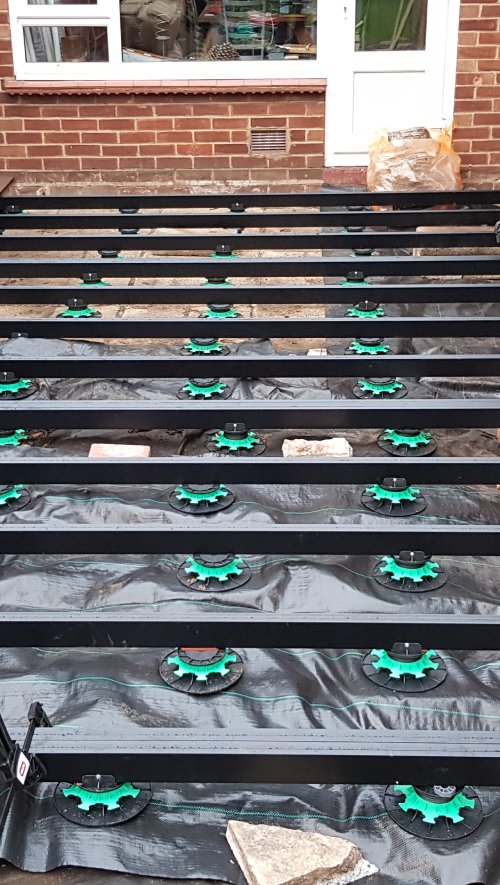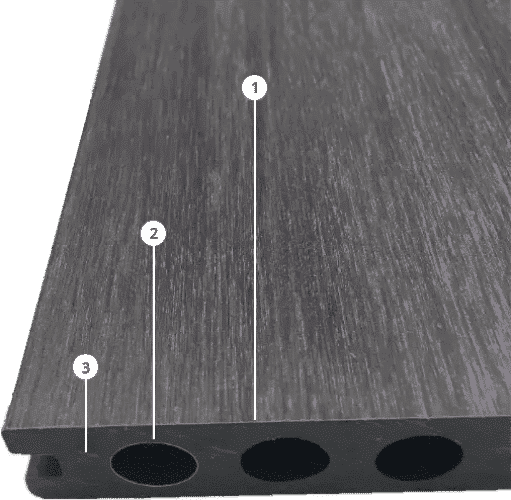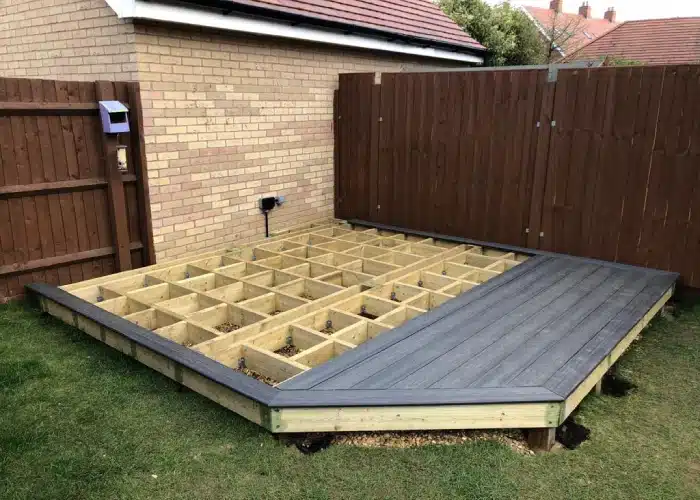What Is Capped Composite Decking?
Can You Lay Composite Decking Straight On Concrete
Composite decking boards are known for being durable and low maintenance. They are considered one of the best flooring options for outdoor garden spaces. Because of this, you may have thought of installing one on top of your existing concrete flooring. The question is, can you lay composite decking straight on concrete? Yes, you can lay or install composite decking on concrete if you wish to. We have compiled some frequently asked questions surrounding laying composite on a concrete surface if you are deciding whether to complete this process or not.
FAQs from customers
Do You Need To Build A Frame?
Concrete is an ideal foundation to build decking on top of, as it makes the process quicker and more stable than building on top of a soft surface. However, you cannot install composite decking boards directly on top of the concrete. You will need to create a frame first, to support the decking’s stability and ensure a long lifespan. This raises the decking boards off the ground, which also prevents damage caused by moisture, extending the longevity of the boards.
What If The Ground Isn’t Even?
Your existing concrete might not be an even surface. You may wonder what to do in this situation and whether you can still lay decking on top of it. If the ground is not level, you may need to use adjustable pedestals to level the installation area. You will also need to solve the potential problem of water pooling by making a drainage system. If the concrete has any cracks on it, it risks sinking, along with the composite decking that you will be installing on top of it. Also, many experts do not recommend laying composite decking on low concrete slabs, as water pooling can be a potential issue.
Do I Need To Create A Gradient?
In order to allow drainage and surface runoff, you will need to ensure a slight gradient of at least 2.5% on your decking surface. This slope should be directed away from your property, so the water flows away from your house and won’t create any flooding. A gradient should already be in place with your current concrete or paving, you will need to check this and work your design of your decking in with the current gradient, that’s to make things easier of course. If your current concrete is experiencing water pooling, you will need to fix this, one way to achieve this is by using a self-levelling compound or a concrete topping mix. You can also caulk the concrete slab to help fix any cracks and prevent further water damage, this is a short term fix in most cases but it will prevent water or crack form getting any worse.
What is a sleeper system?
A sleeper system is a substructure that is necessary to construct between the decking and concrete flooring. Your sleeper system ensures adequate drainage and ventilation, which prevents any damage from occurring to your decking boards. A sleeper system consists of joists at least 38mm in height and width to install decking, they will create a grid-like structure that your decking will sit on. If you are using this method, you will want to use water-resistant materials and make sure that the concrete slab is free from issues. For composite decking, the recommendation is to use pressure-treated (PT) wood or composite battens 50mm. While you can follow the concrete slab’s slight slope, you can also use spacers to support your sleepers drying out, instead them sitting in damp or wet ground. You secure the sleepers in place by drilling them into the concrete carefully.
How do I avoid moisture damage?
You will need to fix any drainage problems, such as pooling and water run-off. If your concrete slab is not flat, you may need to resurface and level it to combat these issues. You can use composite sleepers/ joists to reduce any issues of water damage from occurring. Composite is more resilient against water than wood, therefore, will last longer in a wetter climate and is less susceptible to damage. After installing the sleeper system, it is best to add protection by covering it with damp proof course (DPC) tape or paint with tanking paint. It prevents the material from absorbing too much moisture, which is quite helpful if you are using wood rather than composites. Tanking paint or Damp-Proof Course (DPC) tape can be purchased from most DIY stores or builder’s merchants.
Do the joists need spacing?
After installing the sleepers, you will need to drill the sleeper joists according to the instructions. In most cases, you will need to space the joists by no greater than 300mm in the centre. This spacing will need to be 200mm for commercial projects, allowing for more pressure and footfall.
Can I Use Composite Decking Tiles on concrete?
Another way of installing composites on concrete is by using composite decking tiles. To do this, you will still need to level and waterproof your concrete slabs. However, installing composite tiles is easier, as you can lay them on the surface straight away. You may need a saw to cut the tiles according to the shape of the layout of your planned decking. Decking tiles are usually a temporary solution, and are popular with renters and homeowners not looking for long-term flooring material.
1 Preparation
Before you start building a deck over the patio, you’ll need to ensure you have the right tools and enough materials to finish it. You’ll need the usual construction tools, such as circular or mitre saws, hammers, drill, screws, and levels. You’ll also have to acquire all the decking materials, including the boards and the framing. Besides wood, you can also choose alternatives such as PVC or composite decking. You’ll also want to fix any issues with your concrete, such as water pooling and cracks.
2 Design and Layout
The next step is to design the substructure’s layout. The substructure will serve as the frame of the decking and protect it from ground contact. You can use a marker to map the locations of the beams and joists on your concrete patio. You’ll want to have at least 300mm (30cm) on-centre gaps between the deck joists. Without correct spacing, your deck will be more susceptible sagging and wobbly/bouncy deck boards. Flashing your decking joists is also crucial to help prevent water problems. Lastly, as previously mentioned you can use spacers to slightly lift your sleepers of the ground to help them dry out. You’ll also want to consider any local safety regulations and follow instructions from your decking suppliers.
3 Pick Your Material
Once you check your concrete patio and paving ensuring no cracks, damage and water can drain off easily (please note this is key to a long lasting deck and subframe if your unsure, please get a professional view). Its time to pick the material you are going to use.
You have a few options when building straight onto concrete wooden or composite joists, raised with posts or adjustable pedestals with wood or composite joists on top.
As long you have good drainage, concrete level and no damage, we personally wouldn’t use posts or adjustable pedestals, we only use adjustable pedestals if the ground was uneven, so on this installation we use composite battens/ joists and pedestals.
4 Build Your Frame With Battens
Composite Battens 50mm x 50mm can you installed straight onto the concrete patio or paving as you can see in the image to your right. The frame will be build like a ground level or raised deck in a grid like formation with joist centre or joist spacing at 300mm. Laying a weed membrane is advisable to stop any weed growth.
The battens will need to be anchor to the concrete, you can do this by bolting them in place going at least one inch deep, to do this simply drill in your composite batten like you would with wood, as our composite batten are a solid core this will take a little more elbow grease than with wood, its advisable to use galvanised countersunk concrete bolts and secure in place every 500m intervals.
If you are having any adjoining battens that meet or end, best practise would be to add a joist cross member or sistering joist to adjoin another frame, if you are butting the battens end to end or close to a wall, then ensure you leave a 10mm gap and screw into place using a cross member to securely fix in place for adjoining joists or batten, please use structural screws, as this will be a weak point of structural integrity.

5 Using Pedestals
If your using pedestals then we this would mainly be used for uneven concrete and paving. Pedestal come in different heights and you can use composite or wooden joists. These could also be used if you looking to slight raised your subframe to maybe allow you to walk straight onto the deck from your patio doors.
If you are using pedestals we would recommend using composite joists with your pedestals as more than likely you subframe is going to be close to the ground and wood closer to the ground normally means a shorter life span, so we would personally use composite due to its resistance to moisture.
You will first need to set you pedestals out adjusting them to the desired height for your subframe ensuring you keep a gradient for your deck. The amount of pedestals require to note is 8/9 every sqm based on joist centre at 300m.
Once done simply lay your joist in place and like above any adjoining, you will need a cross member and ensure a 10mm gap for expansion, you can see example below on pedestals used on existing concrete, please note a weed membrane is used in this image and this is always good practise along with gravel/aggregate if needed.

6 Laying Your Boards
Once your frame is in place you can now start laying boards, like installing composite decking the process is exactly the same. Start with your start clip every 300mm intervals and place your first board into position ensuring a 20mm gap between any fixed objects.
Once you first board is in place you can now start to use you slim clips or hidden fasteners, ensuring you leave a 3mm gap side to side, please note even if you using slim clips or 3mm clips the boards can alter, so checking for 3mm as you go along is key.
Any boards meeting end to end will require a 6mm gap and a double joist to hold securely in place with added strength, On you last board remember to pre drill 2mm bigger than the screw head and fix every 300mm intervals at a 45 degree angle.
Conclusion
Can you lay composite decking straight on concrete? Yes, you can lay or install composite decking on concrete if you want to. You will have to ensure that an accurate frame is constructed between the concrete and decking boards in order to allow ventilation and drainage.
What Base Do You Need for Composite Decking?




